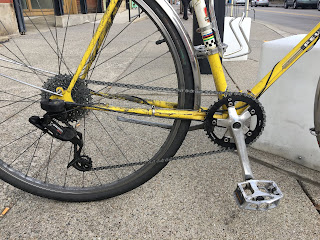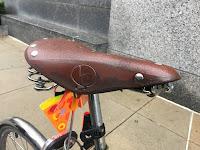This bike came to be the way it is for many reasons, and all of the planning or brainstorming in the world couldn't have made it work out as well as it did when everything finally came together.
My friend Donna, who was my neighbor during my first two years living in Pittsburgh, owned this bike. I think she was the original owner, but she hadn't ridden it in decades. It hung like this in her basement when she showed it to me and I promised that I'd help her find a home for it. I ended up telling her that I might want to buy the bike for myself, which she was ecstatic to hear. I started thinking about what I'd want to do with it. I felt like I wanted upright handlebars and a front carrier to make it easy to clip the rear wheel onto a bus rack. For months, I thought the way to go would be narrow city bars and an internal gear hub to keep things simple and make it easy to move the bike around the city and inside buildings.
I finally picked the bike up late in the summer and realized that while the bike was much too big for Donna, it was the perfect size for me. I also had weird mixture of parts and the AVA death stem was still in place.
The plastic Simplex derailleurs had been replaced with Suntour and Shimano units in the 1980s ...
... yet, the original plastic (and broken) shifters were still there. The Mafac center-pull brakes had also been swapped out for early Shimano Tourney units and the front wheel did not have a knurled braking surface like the original would have.
By the time I picked up the bike, I was about to start delivering food as a side-job. I spent the first couple weeks racking up miles on the Raleigh Stuntman with clipless pedals, having a lot of fun but wondering what I'd do for a budget drivetrain to traverse the hills in the area. I was ready to settle for an 8-speed 11-34-tooth cassette due to availability of parts, but I ended up finding a SRAM DualDrive rear wheel for cheap at the local bike co-op. The DuaDrive is a 3-speed internal hub with an 8-speed freehub, effectively acting as a 3x8 drivetrain but without the clunky-shifting front chainrings.
The proprietary SRAM DualDrive shifter can be seen below, with a twist grip controlling the derailleur and a thumb trigger on the bottom controlling the 3-speed hub. It's the perfect setup for this bike. I use the full range of gears during my deliveries and there is noticeably less drag in the hub compared to the usual Sturmey-Archer AW, which I already thought was pretty good.
Another important piece of this bike is the Fairdale MX handlebar. I bought the bar because I wanted to build a project around it and when the idea to build the Peugeot for deliveries came about, it seemed like the perfect choice. And it was. I decided to retain its full width, which makes a heavy front load extremely easy to control. The handlebar, along with a quill-to-threadless stem adapter and 65mm threadless stem, fit me perfectly when slammed at the lowest setting. The ends are double-wrapped with padded fake leather tape.
I had initially intended to use a BMX stem on the bike due to the narrow French steerer tube, but after finding that the fork was bent, I grabbed the replacement fork I had used on my old Ross years ago and stripped the paint off. It is for this reason that I had to use the quill stem adapter and a threadless stem with shims - there is obviously no way to slide a regular stem without a face plate onto a BMX handlebar.
After not having used this Intelligent Design Works 700c dynamo front wheel in over two years, I decided to use it for this bike so I wouldn't have to worry about charging my lights every day. Originally used on my Lotus the first time I built that bike, it sat for two years in my pile of wheels. The Vittoria Randonneur Cross 700x35c tires are also from that build and the rear one is already almost completely spent after two months.
The seat post is a funny story. Apparently, Peugeot may have been making these bikes so fast that quality control suffered and the insides of the seat tubes were not completely uniform. This resulted in almost every bike having a smaller seat post with a shim to accompany it. I initially was okay with keeping the post and shim, but because I was constantly getting on and off the bike, I found that I could really never get the clamp tight enough to keep the seat from turning, According to people on bikeforums, even the seat posts and shims varied in size. One thread discussing this matter reached a consensus that 26.0mm was the actual interior diameter. I bought a 25.8 alloy post fully expecting there to be some resistance getting it in ... I should have bought a 25.6, but I got it in there. I'll have a lot of fun trying to get the seat post out a year from now when I need to re-grease it.
I initially built the bike with side pull brakes from the parts bin, but they proved to be inadequate after the first rain storm so I went for the popular Tektro R559 calipers and Kool Stop Continental brake pads. Accompanying them are new Sturmey-Archer brake levers with the rubber padding which are very long, hefty, and comfortable.
As a side note, the rear reflector is a Safety Pizza and I would recommend fun things such as this to dissipate the aggression of motorists who seem to get angry at the very sight of a bike on "their" roads.
This bike has several Velo Orange components. The stainless fenders are nice and solid and have yet to become dented or bent on the job. The front fender also goes low enough to keep my feet mostly dry. The VO Model 8 saddle (made by Gyes) was one that I bought a few years back for the Dunelt, but because I almost never rode that bike any sort of long distance, the saddle never got broken in. I put it on the Peugeot with hopes that my long hours in the saddle would help wear it in and I would say it is beginning to happen, but the saddle still feels like a slab of plastic for the most part. It is beginning to be reshaped a little bit. One minor bummer was that after riding the saddle in the rain a few times, I discovered that most of the coloring was applied as a waterproofing layer on the saddle which has begun to peel off. It's not a huge deal. Another bummer is that a minor mishap resulted in the bike flying over my head right as I got home one day, so the saddle rails are bent so that it slopes to the left ever so slightly. I don'it feel it when I ride, so that's okay.
The other Velo Orange component was the French-threaded bottom bracket, which was just recently installed. It is the nicest sealed bottom bracket that I have had my hands on to date. The top-most photo in this thread shows the original 40-52 Nervar steel crankset. Peugeot used softer cotter pins than Raleigh did, as was evident when I tried to remove them. I soaked them in penetrating fluid as I would with the Raleighs, but even then, the tips mushroomed when I tried to press them out. I decided to ride the bike until the pins popped out, but after almost two months, they never popped out. I finally had to drill them out. They were easier to drill than the Raleigh cotter pins; however, once I removed the original bottom bracket, I found that the down tube and seat tube protruded into the bottom bracket shell just enough to block the Velo Orange cartridge unit from going in. I had to grind at the tube ends slowly with a Dremel in order to get enough clearance.
After I got the bottom bracket in, I installed an old 175mm Sugino 110mm BCD alloy crankset paired with the original 40-tooth narrow wide chainring that came on the Stuntman. The narrow/wide teeth on the ring enable me to run a 1x drivetrain with no chain guide or derailleur without dropping the chain.
This bike has proven to be absolutely perfect for the kind of work I do on it. The gear range is perfect for the terrain, the brakes are good, and the cockpit is very comfortable. I don't find the frame to be dead-feeling like the Lotus was, and despite it weighing about 35 lbs with the basket and lock, it really flies.
I don't usually carry this much on the front rack, but the load pictured here was very doable with the large Origin8 rack and the super wide bars.
I think this might be the first time where I was completely happy with a bike after building it. I nailed the gearing and other equipment despite changing every plan at the last minute. Everything is more than satisfactory and there is nothing at the moment that I want to change about the bike.

























No comments:
Post a Comment